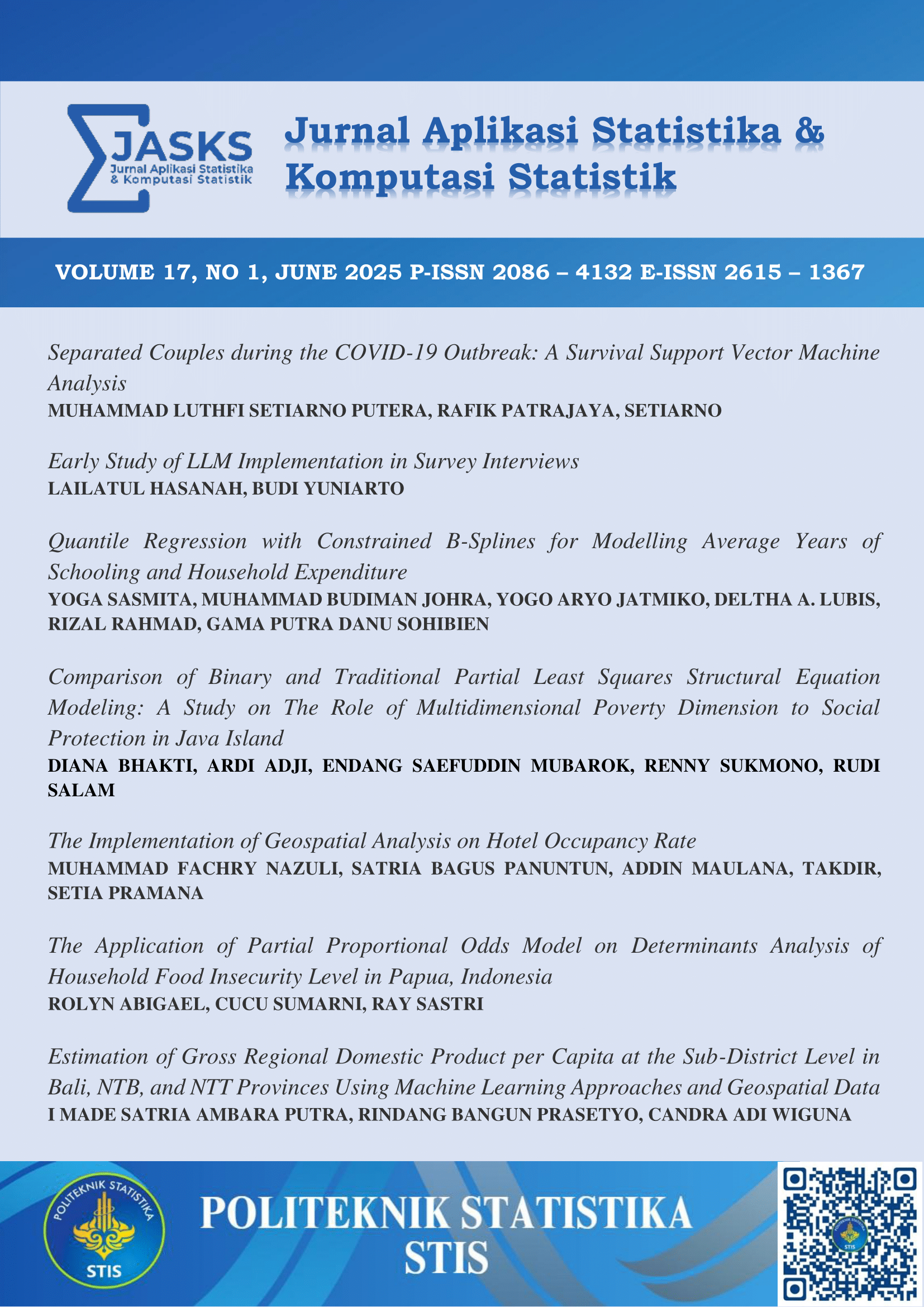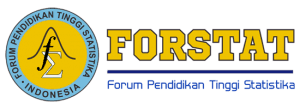Comparison of Binary and Traditional Partial Least Squares Structural Equation Modeling: A Study on The Role of Multidimensional Poverty Dimension to Social Protection in Java Island
DOI:
https://doi.org/10.34123/jurnalasks.v17i1.795Keywords:
Binary PLS-SEM; Item response theory model; Multidimensional poverty; Social Protection; Tetrachoric correlationAbstract
Introduction/Main Objectives: The traditional Partial Least Squares Structural Equation Modeling (PLS-SEM) method uses an ordinary least squares regression approach that assumes that indicators must have a continuous scale. When the indicators are categorical, the use of traditional PLS-SEM becomes less appropriate. Background Problems: Multidimensional poverty consists of dimensions that are measured by a binary scale. The use of binary PLS-SEM is better than traditional PLS-SEM in modeling the effect of dimensions on social protection on Java Island. Novelty: The use of binary PLS-SEM with factor scores from the item response theory model applied to the role of dimensions of multidimensional poverty to social protection has not been carried out yet. Research Methods: This study introduces binary PLS-SEM, which is modified from traditional PLS-SEM by changing the data input using a tetrachoric correlation matrix. Finding/Results: Empirical results show that the binary PLS-SEM measurement model is better than traditional PLS-SEM. Evaluation of the structural model shows that the path coefficients of binary PLS-SEM are better than traditional PLS-SEM. Both approaches have an overall model fit. The order of multidimensional poverty dimensions that affect social protection are education, living standard, and health.
Downloads
References
M. Sarstedt, J. F. Hair, M. Pick, B. D. Liengaard, L. Radomir, C. M. Ringle. “Progress in partial least squares structural equation modeling use in marketing research in the last decade,” Psychology and Marketing, vol. 39, no. 5, pp. 871-873, 2022.
J. Wang & X. Wang, Struktural Equation Modeling: Applications using MPlus 2nd Edition. Chichester: John Wiley & Sons Ltd, 2020.
K. G. Jöreskog, U. H. Olsson, & F. Y. Wallentin, Multivariate Analysis with LISREL. Springer, 2016.
K. A. Bollen, A. Diamantopoulos. “In defense of causal-formative indicators: A minority report,” Psychological Methods, vol. 22, no. 3, pp. 581–596, 2015.
C. Crocetta, L. Antonucci, R. Cataldo, R. Galasso, M. G. Grassia, C. N. Lauro, & M. Marino. “Higher-Order PLS-PM Approach for Different Types of Constructs,” Social Indicators Research, vol. 154, no. 2, pp. 725–754, 2021.
F. Schuberth, J. Henseler, & T. K. Dijkstra. “Partial least squares path modeling using ordinal categorical indikators,” Quality & Quantity: International Journal of Methodology, vol. 52, no. 1, pp. 9–35, 2018.
V. Savalei. “Improving Fit Indices in Structural Equation Modeling with Categorical Data,” Multivariate Behavioral Research, vol. 56, no. 3, pp. 390–407, 2020.
G. Cantaluppi. A partial least squares algorithm handling ordinal variables also in presence of a small number of categories. arXiv: Methodology. preprint arXiv:12125049. 2012.
G. Cantaluppi and G. Boari, “A partial least squares algorithm handling ordinal variables,” in The Multiple Facets of Partial Least Squares and Related Methods: PLS, Paris, H. Abdi, V. E. Vinzi, G. Russolillo, G. Saporta, and L. Trinchera, Eds. Cham: Springer International Publishing, 2016, pp. 295–306.
F. Schuberth and G. Cantaluppi, “Ordinal consistent partial least squares,” in Partial Least Squares Path Modeling, H. Latan and R. Noonan, Eds. Cham: Springer International Publishing, 2017, pp. 109–150.
M. Sarstedt, J. F. Hair, J. Cheah, J-M. Becker, C. M. Ringle. “How to Specify, Estimate, and Validate Higher-Order Constructs in PLS-SEM,” Australasian Marketing Journal, vol. 27, no. 3, pp. 197-211, 2019.
R. Salam, I. M. Sumertajaya, H. Wijayanto, A. Kurnia, T. Sirait. “Higher Order Partial Least Squares Path Modeling Using Binary Data: An Application on Multidimensional Poverty and Social Protection in East Java Province,” Asian Journal of Mathematics and Computer Research, vol. 30, no. 4, pp. 118–137, 2023.
J. P. Miller, Essential Statistical Methods for Medical Statistics: A derivative of Handbook of Statistics: Epidemiology and Medical Statistics, vol. 27. Amsterdam: North Holland, 2011.
S. Alkire, J. E. Foster, S. Seth, M. E. Santos, J. M. Roche, P. Ballon, Multidimensional Poverty Measurement and Analysis. Oxford: Oxford University Press, 2015.
W. Hanandita, G. Tampubolon, “Multidimensional Poverty in Indonesia: Trend Over the Last Decade (2003–2013),” Social Indicators Research, vol.128, pp.559–587, 2016.
UNDP, Why is the MPI better than the Human Poverty Index (HPI) which was previously used in the Human Development Reports? Frequently Asked Questions, 2015. United Nations Development Programme (online). http://hdr.undp.org/en/faq-page/multidimensional-povertyindex-mpi#t295n138. [Accessed: February 27, 2014].
A. Khaliq, B. Uspri, “Kemiskinan Multidimensi dan Perlindungan Sosial [Multidimensional Poverty and Social Protection],“ Jurnal Manajemen, vol. 13, no. 2, pp. 85-191, 2017.
Prakarsa, Indeks Kemiskinan Multidimensi Indonesia 2015-2018 [Indonesia Multidimensional Poverty Index 2015-2018], Laporan, Perkumpulan Prakarsa, Jakarta, 2020.
M. E. Rademaker, Composite-based Structural Equation Modeling. Ph.D. Dissertation, University of Würzburg, Faculty of Economics, 2020.
E. E. Rigdon, “Partial least squares path modeling,” in Structural Equation Modeling – A Second Course, 2nd ed., G. R. Hancock and R. O. Mueller, Eds. Information Age Publishing, Inc., 2013, ch. 3.
M. Mehmetoglu, S. Venturini, Structural Equation Modelling with Partial Least Squares Using Stata and R, 1st ed. Chapman and Hall/CRC, 2021.
Joreskog, K. G, Structural Equation Modeling with Ordinal Variables using LISREL. Scientic Software International Inc., 2005. http://www.ssicentral.com/lisrel/techdocs/ordinal.pdf.
K. A. Bollen, A. Maydeu-Olivares, “A polychoric instrumental variable (piv) estimator for structural equaltion models with categorical variables,” Psychometrika, vol. 72, pp. 309-326, 2007.
F. Drasgow, “Polychoric and polyserial correlations,” in Encyclopedia of Statistical Sciences, L. Kotz and N. Johnson, Eds. New York: Wiley, 2014, pp. 68–74.
J. Brzezi?ska, “Item response theory models in the measurement theory,” Communications in Statistics - Simulation and Computation, vol. 49, no. 12, pp. 3299–3313, 2018.
E. F. El-Hashash, K. M. El-Absy, “Methods for Determining the Tetrachoric Correlation Coefficient for Binary Variables,”, Asian J. Prob. Stat., vol. 2, no. 3, pp. 1–12, Dec. 2018.
J. Suárez-Cansino, V. López-Morales, L. R. Morales- Manilla, A. Alberto-Rodríguez, J. C. Ramos-Fernández, “Prior Distribution and Entropy in CAT Ability Estimation through MAP or EAP,” Entropy, vol. 25, no. 1-50, pp. 1-21, 2023.
F. B. Baker, S. Kim, Item response theory: parameter estimation techniques. New York: CRC Press, 2004.
C. M. Bishop, Pattern Recognition and Machine Learning. Cambridge: Springer, 2006.
J. Fox, Bayesian item response modeling: theory and applications. Springer, 2010.
R. D. Bock, R. D. Gibbons, Item Response Theory. University of Chicago: John Wiley & Sons, 2021.
R. K. Hambleton, H. Swaminathan, and H. J. Rogers, Fundamentals of Item Response Theory. Newbury Park, CA: Sage, 1991.
R. J. de Ayala, The Theory and Practice of Item Response Theory. New York: The Guilford Press, 2022.
L. Steinberg and D. Thissen, “Item response theory,” in The Oxford Handbook of Research Strategies for Clinical Psychology, J. S. Comer and P. C. Kendall, Eds. Madison Avenue, NY: Oxford University Press, 2013, pp. 336–373.
S. Alkire, J. Foster, “Counting and multidimensional poverty measurement,” Journal of Public Economics, vol. 95, no. 7-8, pp. 476-487, 2011.
[WB] World Bank, Social protection sector strategy : from safety net to springboard (English). Washington, D.C. : World Bank Group, 2001.
A. Barrientos, D. Hulme, “Chronic Poverty and Social Protection: Introduction,” The European Journal of Development Research, vol. 17, no. 1, pp. 1–7, 2005.
A. Haan, “Social Exclusion: Enriching the Understanding of Deprivation,” Studies in Social and Political Thought, vol. 2, 2000.
L. Scott, Social Protection: Improving its Contribution to Preventing Households Falling into Poverty, 2016.
G. Sanjivi, “Social security options for developing countries,” International labour review, vol. 133, no. 1, pp. 35-53, 1994.
R. Sabates-Wheeler, S. Devereux, “Social Protection for Transformation,” IDS Bulletin, vol. 38, no. 3, pp. 23–28, 2007.
International Labour Organization, Penilaian Landasan Perlindungan Sosial berdasarkan Dialog Nasional di Indonesia: Menuju Landasan Perlindungan Sosial Indonesia [Assessment of the Social Protection Baseline based on the National Dialogue in Indonesia: Towards the Indonesian Social Protection Baseline], Laporan: Jakarta, 2012.
J. F. Hair Jr., G. T. M. Hult, C. M. Ringle, M. Sarstedt, N. P. Danks, S. Ray, Partial Least Squares Structural Equation Modeling (PLS-SEM) Using R: A Workbook. Springer Cham, 2021.
J. F. Hair, G. T. M. Hult, C. M. Ringle, and M. Sarstedt, A Primer on Partial Least Squares Structural Equation Modeling (PLS-SEM), 2nd ed. Thousand Oaks, CA: Sage, 2017.
J. Benitez, J. Henseler, A. Castillo, F. Schuberth, “How to perform and report an impactful analysis using partial least squares: Guidelines for confirmatory and explanatory IS research,” Information and Management, vol. 57, no. 2, pp. 103168, March 2020.
J. Henseler, C. M. Ringle, and M. Sarstedt, “A new criterion for assessing discriminant validity in variance-based structural equation modeling,” Journal of the Academy of Marketing Science, vol. 43, no. 1, pp. 115–135, 2015.
G. Franke and M. Sarstedt, “Heuristics versus statistics in discriminant validity testing: A comparison of four procedures,” Internet Research, vol. 29, no. 3, pp. 430–447, 2019.
M. I. Aguirre-Urreta, M. Rönkkö, “Statistical inference with PLSc using bootstrap confidence intervals,” MIS Quarterly, vol. 42, no. 3, pp. 1001–1020, 2018.
G. Shmueli, O. R. Koppius, “Predictive analytics in information systems research,” MIS Quarterly, vol. 35, no. 3, pp. 553–572, 2011.
E. E. Rigdon, “Rethinking Partial Least Squares Path Modeling: In Praise of Simple Methods,” Long Range Planning, vol. 45, pp. 341-358, 2012.
J. F. Hair, C. M. Ringle, M. Sarstedt, “PLS-SEM: Indeed a silver bullet,” Journal of Marketing Theory and Practice, vol. 19, no. 2, pp. 139–151, 2011.
S. Raithel, M. Sarstedt, S. Scharf, M. Schwaiger, “On the value relevance of customer satisfaction. Multiple drivers and multiple markets,” Journal of the Academy of Marketing Science, vol. 40, no. 4, pp. 509–525, 2012.















